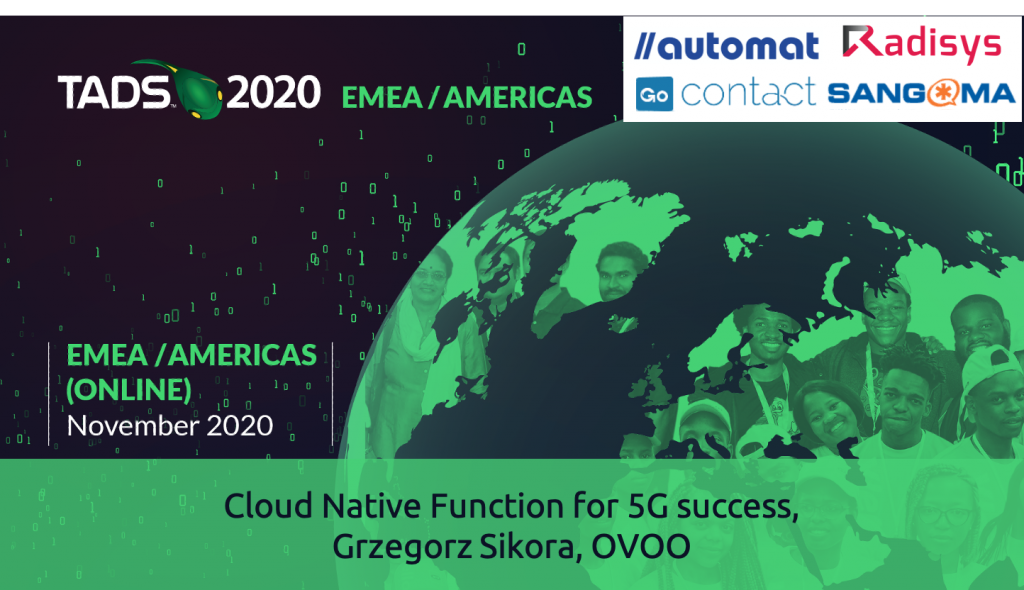Cloud Native Function for 5G success, Grzegorz Sikora, Rafal Mysliwiec, and Pawel Kulpa, OVOO
OVOO’s focus is the migration of telco apps to cloud native. They bring deep open source expertise. Jesus Cruz Manjavacas, VAS Development Expert at PLAY mentioned this expertise in his presentation on Programmable Telecoms inside a Telco.
Greg provided an introduction to OVOO and the blueprint they use for cloud native, which he presented last year at TADSummit EMEA 2019. For this session OVOO builds on the CNCF (Cloud Native Computing Foundation) webinar demo, the step by step migration from VNF (Virtual Network Function) to CNF (Cloud Network Function) for a messaging gateway (one of OVOO’s products).
The messaging gateway provides the bridge between legacy protocols (SIP, MAP, SMPP, and DIAMETER) and cloud native based on Kubernetes (HTTP). In the recap of the CNCF demo they show the legacy and cloud native architectures, with the performance improvements of 14% lower CPU usage, 18% lower memory usage and 35% lower disk usage.
In the demo Pawel provides, he runs through the challenges in adapting the session oriented stacks of SIP/SS7 to kubernetes. With the problems of IP addressing. I also recommend you also check out the Adventures in Real-Time Communications in the Cloud, by Manuel Pombo, VP of Engineering GoContact. Which also covers this issue.
Pawel then runs through a cool continuous deployment demo using Jenkins Pipeline to set up a messaging gateway on a kubernetes cluster, with a GUI to configure the platform, which is connected to an SMPP provider. And then transmits live traffic, sender being TADSummit using the GUI to configure 🙂 There’s a load of work under the hood in making the core of a telco run cloud native. Critically all the cloud native ecosystem tools are available beyond Jenkins covering OAM, metrics, availability, scalability, security, etc. This is excellent progress from last year, well done Greg, Rafal, and Pawel.
Greg wraps up explaining the benefits to telcos of migrating their applications to cloud native and the massive ecosystem of open source tools available. And most importantly the large base of expertise across web developers who understand these tools, its no longer a telco special.
Slideshare is having difficulties today, here’s a direct link to Greg’s slides.
Session Description from the Agenda
5G is no longer the technology of the future – it is here and now. It is the fourth industrial revolution.
In the TELCO world we believe how powerful an open ecosystem is – understanding it is the basis, the key to further development, profits and success. This is the right time to implement solutions that will be compliant with the 5G standard and will help companies to grow.
It’s an awesome opportunity for us and we are proud that we can show how to achieve significant cost reduction using open source projects, how effective and flexible the open source system is. You will experience live demo presentation – step by step migration to Cloud Native Function.
We want to be with you as part of the fourth industrial revolution.


Thank you for an excellent presentation and demo, building on your presentation from last year.
Sebastian Schumann gave an excellent review of the challenges facing telcos in migrating to the cloud, https://blog.tadsummit.com/2020/11/02/serverless-opinions/. For example, highlighting the challenges of programmatic resource allocation given how telcos perform financial planning.
How do you help telcos get around the process / cultural issues in moving to cloud native?
Hi Alan,
so I thought you’d like it. We’ve worked a bit to do this. I hope it was understandable.
On the demo, I did not mark one important point. We cannot think of 5G and Kubernetes without support for the legacy protocols that are crucial to migrating to CNF.
I fully agree with Sebastian than one of the hardest things is the question of old habits.
When I talk to my clients and show what can be done in the transformation to CNF, the question usually arises “Where is the platform?” 🙂 For many people the Application Server is synonymous with the platform.
Here you need to realize that the platform functions that have been implemented in every solution so far are taken over by “cloud”, HA, resilience, logging, alarming, tracing, session replication etc.
Wouldn’t communications in 5G demand MEC (Multi-Access Edge computing) for real-time synchronous or asynchronous communications? Tx
Yes, of course, but what we wanted to focus on in this demo is to show how you can deal with the challenges posed by the CNF against solutions requiring legacy protocols.
The second aspect was “Cost effectiveness” and the possibility of using open source.
Some of our clients are not entirely convinced that it is possible to get high SLA and low TCO at the same time.
We have proved that it is possible